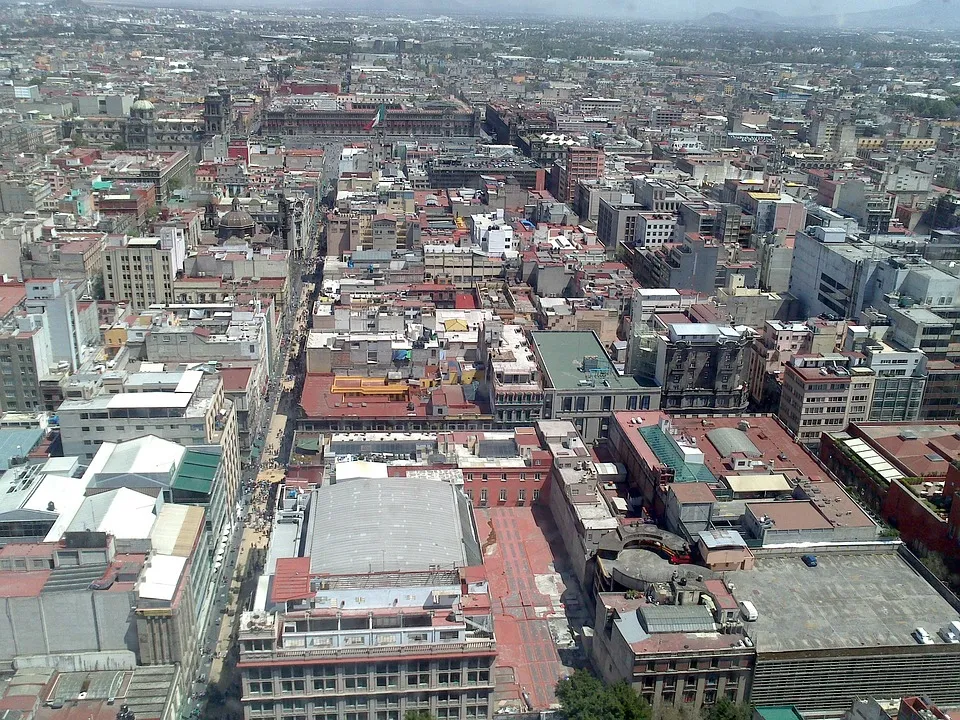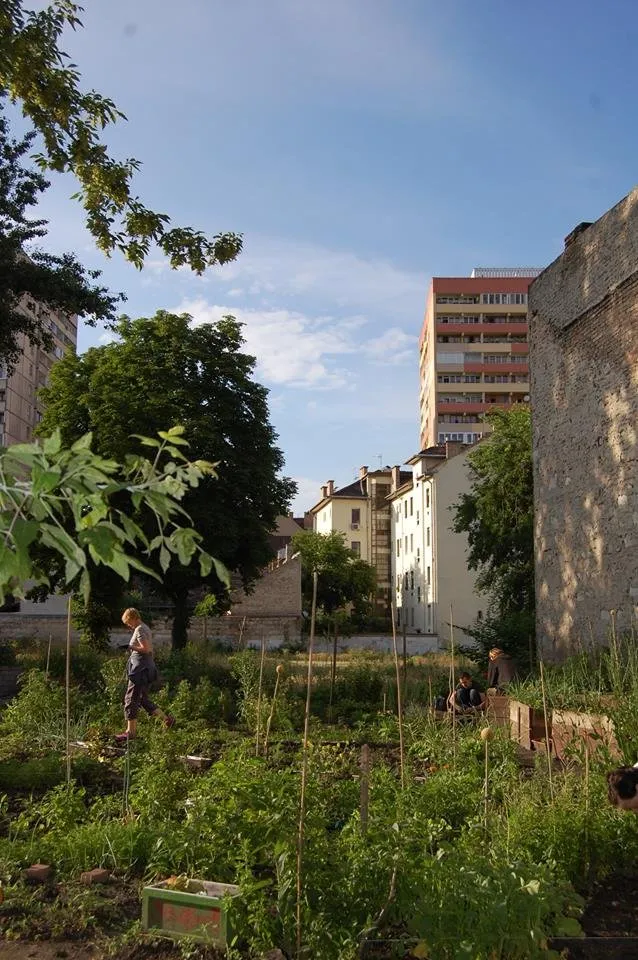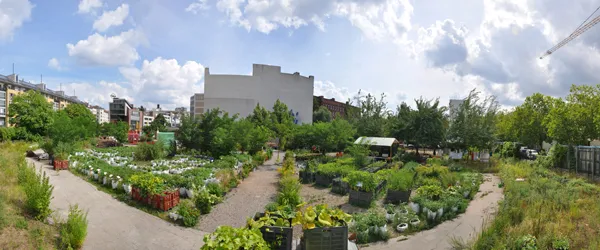Living in a major metropolis, one of the largest on this continent, I can't get around addressing urban Permaculture. This may sound like an oxymoron to many people, since Permaculture is generally associated with food-forests, natural landscapes, farms, gardens, and the like. But what sort of Permaculture is possible in a place where close to 9000 people live on a square kilometer, and much of that space is taken up by motor vehicle infrastructure? The answer is a lot, though not surprisingly, farming is only a small part of it.

Rooftop Gardens: Food Production on a Limited Space
Okay, let's not write off food production completely. After all, it tackles one of the most basic human needs, and food-related self sufficiency is a major challenge, not only in cities. It is difficult enough to meet ALL your nutritional needs on your own, even if you have a couple of hectares of good farmland. However, supplementing your complete dependence on the supermarket trucks by growing some kitchen herbs on your windowsill already makes a huge difference, and it's fairly simple to do. From there on it's only a small step to some tomatoes in a bucket, maybe some chili peppers, some kale and spinach, (…) until you have converted your entire roof space into a thriving garden, with all types of plants growing out of bags, pots, and boxes. For those who are fortunate enough to have a little yard behind their house, planting a couple of fruit trees is a beautiful addition, with many more benefits than the occasional lime for their margarita. Urban gardening can take on extreme forms, where limited space is frequently countered in many creative ways. Before soon it may feature a composting bin, a small greenhouse, rainwater catchment, or even an aquaponic system. As ingenious as these setups may be, they still don't necessarily constitute urban permaculture.
Urban Farms and Community Gardens
Those who don't have a yard, or access to their roof, or even a balcony, are faced with a challenge that puts them potentially a lot closer to Permaculture: becoming involved in community farms. Many city dwellers around the world have organized themselves to gain access to available plots where they can set up a farm, usually temporarily, at a site where no construction is planned for the foreseeable future. Some of the examples I have seen include the Grundkert in Budapest, the Prinzessinnengarten in Berlin, or the Hayes Valley Farm in San Francisco. Though essentially similar, there are some major differences between these projects.
The Grundkert, the community garden I had the most contact with around 2011-12, got permission to use a small plot in Budapest's ninth district, where modern apartment blocks and a fancy shopping mall left some area unused... for a little while. Though the group gave some considerations to a central composting bin and a communal storage shed, members received a rectangle of few square meters each, which they could use however they wanted. It's a well intended project, and letting people garden side-by-side brings them a bit closer together than having them do it on their own separate rooftops. Still, it is just a small step closer to the idea of Permaculture. By now the original site of this farm has been returned to urban growth, but the group is still active elsewhere in the city.

Similarly, Hayes Valley Farm was also a temporary project to put the city block into good use, which used to be the on-ramp to the freeway that's been torn down after being damaged in an earthquake. I visited the place in 2010, and was amazed how well organized it looked. Far from dividing the land into independent plots, they were implementing large-scale improvement to the soil, such as heavy-duty sheet-mulching, and planting fava beans to fix nitrogen. They also seemed quite involved with local circles to get resources, such as cardboard or manure, they had many programs bringing in artists and musicians, and needless to say, they had multitudes of volunteers trying to lend a hand. Once again, though the site has been closed, the project is continuing elsewhere in San Francisco.

Finally, the Prinzessinnengarten is probably the best executed urban farm I have come across, though I only spent one afternoon there five years ago. During my short visit it became apparent how well organized it was, and how plants, as numerous as they might be, were only a small part of all the things they were involved in. A look at their website presents such terms as “neighborhood academy”, “gardening consultancy”, and “re-use material warehouse”. This amazing group is out to connect people and things, thus meeting needs and finding uses, in other words closing loops, which is exactly what Permaculture is about. Next to all this, their café and flea-market don't even seem that extraordinary any more, just other pieces of the same mosaic.

The Essence of Urban Permaculture: Getting to Know Your Neighbors
So what is all this Permaculture about, if not about companion planting? The answer is widening the scope to include other things as well. And yes, the most frequently occurring element in a city are still people. So I guess we could say companion living.
Just as with all other elements, Permaculture looks at their characteristics, at their behavior, their products and needs, the input and output. Just like with a chicken, that produces eggs, manure, and scratchings (among other things), and needs water, shade, and other chickens (among other things), each one of us has their own needs and products. Who has any surplus of what? Which needs are not met? Where is too much or too little of something? How could we connect them to others?
We're Back to the Market
As much as I love talking about the Mercado Alternativo de Tlalpan, that is the producers' market I am involved with here in Mexico City, I think it is still not so much Permaculture. The biggest problem is its location (or my own). Taking a thirty minute taxi ride to the southern part of the city, where the market is located and where I have an established customer base, makes my products a bit less then local. Maybe it's not as bad shipping sweatshop products across the globe, but it is pulling in the same direction.
In comparison, getting my hair cut at the barber shop of the guy who used to live in the same apartment building as me, is a lot closer to the idea of Urban Permaculture. Striking deals, where I pay for my haircut with a bottle of kombucha, is even better. Selling my probiotic drinks at the pizzeria his friend is opening, is yet another step further.
Invisible Structures – The Backbone of Urban Permaculture
So while swales and keylines may not be at the forefront of Urban Permaculture, there are many things that can be done. Needless to say, most of it has to do with community organizing, so close cooperation with established institutions is usually a key factor. This doesn't mean only City Hall, by the way, though often times there is no getting around it so one might as well establish a good connection with them. In the end, it's always about links between people, so the result depends on what they are interested in, what they have to offer, and what they need. Car pooling, tool libraries, or time share programs, where people exchange services, paid for in hours instead of dollars, are some of the ways of exchanging value directly, establishing connections between neighbors, and fostering interdependence among each other, instead of dependence on outside factors.
Although these issues are especially important in cities, they are not absent from rural farms, far away from civilization. The biggest difference may be that due to the relative scarcity of humans in rural regions, country folks have always had an open attitude toward connecting with each other, if nothing else for mere survival. In cities, where people generally tend to ignore each other, bringing these connections back is one of the most important aims of Urban Permaculture.